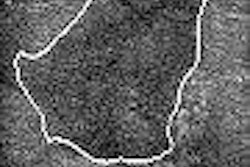
(Radiology Review) Korean radiologists recently used the Breast Imaging Reporting and Data System (BI-RADS) to evaluate the frequency, imaging features, and the clinical relevance of focal fibrosis of the breast diagnosed by a sonographically guided core biopsy of nonpalpable lesions.
According to Dr. Jai Kyung You and colleagues, the "imaging findings and clinical relevance of nonpalpable, focal fibrosis diagnosed by sonographically guided biopsy have not been reported." Their study was published in the October issue of the Journal of Ultrasound in Medicine.
The authors described focal fibrosis of the breast as a "histopathologic entity characterized by proliferation of the stromal connective tissue with obliteration of the mammary ducts and lobules." Clinically occult mammographically or sonographically detected breast lesions are commonly found to be focal fibrosis of the breast, they stated.
Two radiologists at Yonsei University College of Medicine in Seoul independently and retrospectively reviewed the sonograms and mammograms for 724 lesions and found 62 cases of focal fibrosis (8.6% incidence). Ultrasound images were available for 56 cases and mammograms were available for 51.
The sonograms and mammograms were first reviewed by two experienced radiologists. Second, both sets of films were reviewed together for each patient. Any discrepancy was resolved by consensus. Review of the mammograms showed that 64.7% (n = 33) had negative findings and that these lesions were detected in either mammographically dense breast (n = 29), or in a different area to a palpable mass (n = 4). "Mammographic findings included a mass with or without calcifications in 14 (27.4%), asymmetry in two (3.9%), and architectural distortion in two (3.9%)," the researchers wrote.
Review of the sonograms demonstrated that, "the most common features were oval shape (32/56, 57.1%), parallel orientation (36/56, 64.3%), microlobulated margin (24/56, 42.9%), abrupt interface (50/56, 89.3%), isoechoic pattern (42/56, 75.0%), and a lack of posterior acoustic features (45/56, 80.4%)." Using BI-RADS, the final assessment for these cases of focal fibrosis was category 3 in 48% and category 4 in 52%.
"Most of the lesions were categorized as probably benign (category 3) or having a low suggestion of malignancy (category 4A)," the authors concluded. They advised that a six-month follow-up protocol was adequate for focal fibrosis diagnosed at core biopsy.
"Focal Fibrosis of the Breast Diagnosed by a Sonographically Guided Core Biopsy of Nonpalpable Lesions: Imaging Findings and Clinical Relevance"
Jai Kyung You et al
Department of Diagnostic Radiology, Yonsei University College of Medicine
134 Shinchon-Dong, Seodaemun-Ku, Seoul 120-752, Korea
J Ultrasound Med 2005 (October); 24:1377-1384
By Radiology Review
October 20, 2005
Copyright © 2005 AuntMinnie.com


















